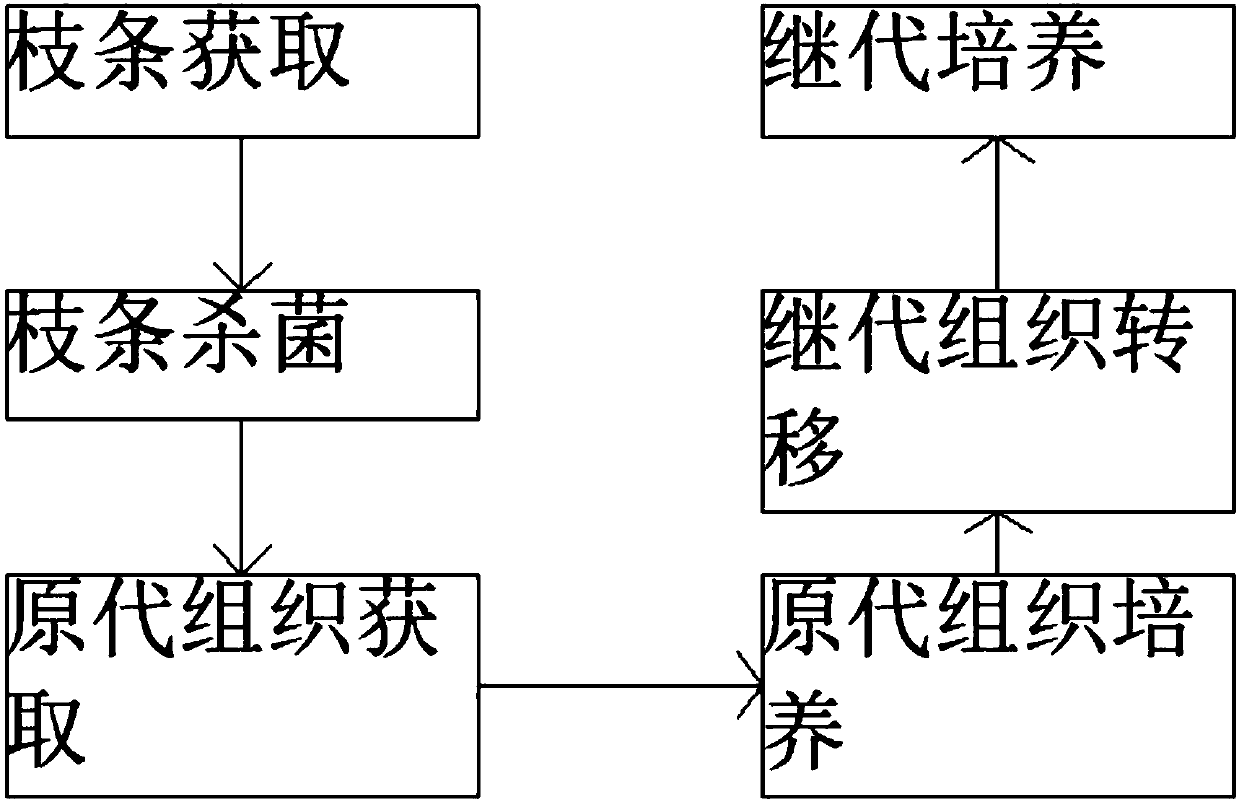Subculture method of tamarix chinensis tissue culture seedling
A technology of subculture and subculture medium, applied in the field of subculture of Tamarisk tissue culture seedlings, can solve the problems such as browning of the base of tissue culture seedlings, endangering survival, proliferation speed and rooting rate, etc., so as to avoid browning. Effect
- Summary
- Abstract
- Description
- Claims
- Application Information
AI Technical Summary
Problems solved by technology
Method used
Image
Examples
Embodiment 1
[0031] The invention discloses a method for subculture of tamarix tissue cultured seedlings. The specific steps are as follows:
[0032] (1), branch acquisition: take the new twigs of the Tamarix plant, and use clear water to wash the twigs, and the washing time is 2 to 3 hours;
[0033] (2), branch sterilization: place the twig after washing in (1) in a concentration of 70% to 75% alcohol for disinfection for 1 to 2 minutes, then rinse with sterile water for 3 to 4 times;
[0034] (3), primary tissue acquisition: cut the epidermis of the twig to obtain the internal tissue:
[0035] (4) Primary tissue culture: place the primary tissue in a vessel containing the primary culture medium, and cultivate it at room temperature at 25°C under light conditions. After culturing for a period of time, the primary tissue cells inside the vessel divide The secondary tissue cells are produced, and with the division of the tissue cells, part of the secondary tissue cells are suspended in the...
Embodiment 2
[0042] The invention discloses a method for subculture of tamarix tissue cultured seedlings. The specific steps are as follows:
[0043] (1), branch acquisition: take the new twigs of the Tamarix plant, and use clear water to wash the twigs, and the washing time is 2 to 3 hours;
[0044] (2), branch sterilization: place the twig after washing in (1) in a concentration of 70% to 75% alcohol for disinfection for 1 to 2 minutes, then rinse with sterile water for 3 to 4 times;
[0045] (3), primary tissue acquisition: cut the epidermis of the twig to obtain the internal tissue:
[0046] (4) Primary tissue culture: place the primary tissue in a vessel containing the primary culture medium, and cultivate it at room temperature at 25°C under light conditions. After culturing for a period of time, the primary tissue cells inside the vessel divide The secondary tissue cells are produced, and with the division of the tissue cells, part of the secondary tissue cells are suspended in the...
Embodiment 3
[0053] The invention discloses a method for subculture of tamarix tissue cultured seedlings. The specific steps are as follows:
[0054] (1), branch acquisition: take the new twigs of the Tamarix plant, and use clear water to wash the twigs, and the washing time is 2 to 3 hours;
[0055] (2), branch sterilization: place the twig after washing in (1) in a concentration of 70% to 75% alcohol for disinfection for 1 to 2 minutes, then rinse with sterile water for 3 to 4 times;
[0056] (3), primary tissue acquisition: cut the epidermis of the twig to obtain the internal tissue:
[0057] (4) Primary tissue culture: place the primary tissue in a vessel containing the primary culture medium, and cultivate it at room temperature at 25°C under light conditions. After culturing for a period of time, the primary tissue cells in the vessel divide The secondary tissue cells are produced, and with the division of the tissue cells, part of the secondary tissue cells are suspended in the int...
PUM
 Login to View More
Login to View More Abstract
Description
Claims
Application Information
 Login to View More
Login to View More - R&D
- Intellectual Property
- Life Sciences
- Materials
- Tech Scout
- Unparalleled Data Quality
- Higher Quality Content
- 60% Fewer Hallucinations
Browse by: Latest US Patents, China's latest patents, Technical Efficacy Thesaurus, Application Domain, Technology Topic, Popular Technical Reports.
© 2025 PatSnap. All rights reserved.Legal|Privacy policy|Modern Slavery Act Transparency Statement|Sitemap|About US| Contact US: help@patsnap.com

